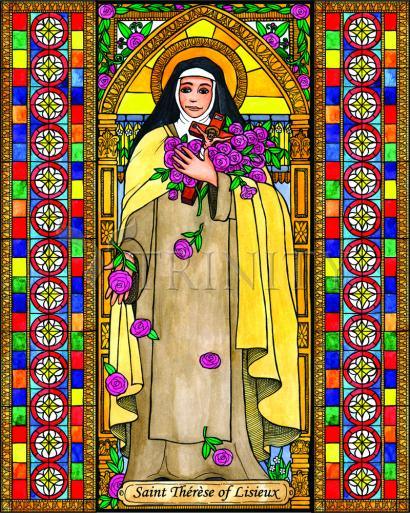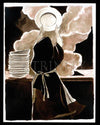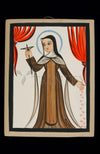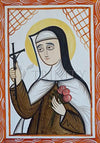Collection: St. Thérèse of Lisieux

-
Sale
Wood Plaque Premium
Regular price From $99.95 USDRegular priceUnit price per$111.06 USDSale price From $99.95 USDSale -
Sale
Wood Plaque
Regular price From $34.95 USDRegular priceUnit price per$38.83 USDSale price From $34.95 USDSale -
Sale
Wall Frame Espresso
Regular price From $109.95 USDRegular priceUnit price per$122.17 USDSale price From $109.95 USDSale -
Sale
Wall Frame Gold
Regular price From $109.95 USDRegular priceUnit price per$122.17 USDSale price From $109.95 USDSale -
Sale
Wall Frame Black
Regular price From $109.95 USDRegular priceUnit price per$122.17 USDSale price From $109.95 USDSale -
Sale
Canvas Print
Regular price From $84.95 USDRegular priceUnit price per$94.39 USDSale price From $84.95 USDSale -
Sale
Metal Print
Regular price From $94.95 USDRegular priceUnit price per$105.50 USDSale price From $94.95 USDSale -
Sale
Acrylic Print
Regular price From $94.95 USDRegular priceUnit price per$105.50 USDSale price From $94.95 USDSale -
Sale
Giclée Print
Regular price From $19.95 USDRegular priceUnit price per$22.17 USDSale price From $19.95 USDSale -
Custom Text Note Card
Regular price From $300.00 USDRegular priceUnit price per$333.33 USDSale price From $300.00 USDSale
ARTIST: Brenda Nippert
ARTWORK NARRATIVE:
Therese Martin was born in France to a devout Catholic family. At 15, she became a Carmelite nun. At twenty-four she died of tuberculosis, but nobody but her sister Pauline and her prioress suspected her sanctity. Therese wrote down her spiritual thoughts. Even though she knew she was dying, she felt her mission was just starting. She said she wanted to spend her Heaven doing good on earth, and let a shower of roses fall after her death. Therese's “little way” was to do everything, no matter how small, to express her love for God.
For example, she would be sociable when she would rather be left alone. She would not complain when another sister accidentally splashed her in the face with dirty laundry water. Simple, seemingly insignificant little things made all the difference, bringing her closer and closer to God. Her “little way” appealed to so many because there is nobody who could not follow it's simple but effective path. Roses began to fall from Heaven in the form of miracles, all over the world. Therese was canonized and called the greatest saint of modern times. Her “little way” takes only a child- like desire to love God, coupled with the constancy to keep it up. When you are asked for help, do it cheerfully, when you are treated rudely, retaliate with kindness. By giving your better side to others, you are offering it to God, just to show Him you love Him.
Her feast day is October 1.
- Art Collection:
-
Saints & Angels
- Patronage:
-
Air Crews,
-
AIDS Caregivers,
-
Black Missions,
-
Diocese of Pueblo CO,
-
Foreign Missions,
-
Illness,
-
Missionaries,
-
Russia,
-
Tuberculosis,
-
Sickness,
-
Religious Freedom in Russia,
-
Loss of Parents,
-
France,
-
Florists,
-
Bodily Ills,
-
AIDS Sufferers,
-
African Missions
- Nippert collection:
-
Saints and Angels
The spread of devotion to St. Therese of Lisieux is one of the impressive religious manifestations of our time. During her few years on earth this young French Carmelite was scarcely to be distinguished from many another devoted nun, but her death brought an almost immediate awareness of her unique gifts. Through her letters, the word-of-mouth tradition originating with her fellow-nuns, and especially through the publication of Histoire d'un ame, Therese of the Child Jesus or "The Little Flower" soon came to mean a great deal to numberless people; she had shown them the way of perfection in the small things of every day. Miracles and graces were being attributed to her intercession, and within twenty-eight years after death, this simple young nun had been canonized. In 1936 a basilica in her honor at Lisieux was opened and blessed by Cardinal Pacelli; and it was he who, in 1944, as Pope, declared her the secondary patroness of France. "The Little Flower" was an admirer of St. Teresa of Avila, and a comparison at once suggests itself. Both were christened Teresa, both were Carmelites, and both left interesting autobiographies. Many temperamental and intellectual differences separate them, in addition to the differences of period and of race; but there are striking similarities. They both patiently endured severe physical sufferings; both had a capacity for intense religious experience; both led lives made radiant by the love of Christ.
The parents of the later saint were Louis Martin, a watchmaker of Alencon, France, son of an army officer, and Azelie-Marie Guerin, a lacemaker of the same town. Only five of their nine children lived to maturity; all five were daughters and all were to become nuns. Francoise-Marie Therese, the youngest, was born on January 2, 1873. Her childhood must have been normally happy, for her first memories, she writes, are of smiles and tender caresses. Although she was affectionate and had much natural charm, Therese gave no sign of precocity. When she was only four, the family was stricken by the sad blow of the mother's death. Monsieur Martin gave up his business and established himself at Lisieux, Normandy, where Madame Martin's brother lived with his wife and family. The Guerins, generous and loyal people, were able to ease the father's responsibilities through the years by giving to their five nieces practical counsel and deep affection.
The Martins were now and always united in the closest bonds. The eldest daughter, Marie, although only thirteen, took over the management of the household, and the second, Pauline, gave the girls religious instruction. When the group gathered around the fire on winter evenings, Pauline would read aloud works of piety, such as the Liturgical Year of Dom Gueranger. Their lives moved along quietly for some years, then came the first break in the little circle. Pauline entered the Carmelite convent of Lisieux. She was to advance steadily in her religious vocation, later becoming prioress. It is not astonishing that the youngest sister, then only nine, had a great desire to follow the one who had been her loving guide. Four years later, when Marie joined her sister at the Carmel, Therese's desire for a life in religion was intensified. Her education during these years was in the hands of the Benedictine nuns of the convent of Notre- Dame-du-Pre. She was confirmed there at the age of eleven.
In her autobiography Therese writes that her personality changed after her mother's death, and from being childishly merry she became withdrawn and shy. While Therese was indeed developing into a serious-minded girl, it does not appear that she became markedly sad. We have many evidences of liveliness and fun, and the oral tradition, as well as the many letters, reveal an outgoing nature, able to articulate the warmest expressions of love for her family, teachers, and friends.
Additional Items Our Customers Like
-

St. Thérèse Doing the Dishes (by Br. Mickey McGrath, OSFS)
-

St. Thérèse of Lisieux (by Br. Arturo Olivas, OFS)
-

St. Thérèse of Lisieux (by Br. Arturo Olivas, OFS)
-

St. Thérèse of Lisieux (by Br. Arturo Olivas, OFS)
-

St. Thérèse of Lisieux (by Dan Paulos)
-

St. Thérèse of Lisieux (by Br. Mickey McGrath, OSFS)


















